The development of high-speed rail has become a symbol of China's development. Almost every year, new high-speed trains are put into service, which means that it becomes easier and easier when you travel in China. In 2018, the high-speed train from Guilin to Hong Kong was opened. Now you can travel directly from Guilin high speed train station to Hong Kong instead of taking a detour from Guilin to other cities and flying to Hong Kong. China Tour Star hopes that the below itinerary could provide you with an in-depth experience of China high-speed trains. During this China Train tour, you will take a Hong Kong to Guilin bullet train and a Shanghai to Beijing bullet train. We still arranged flights if the train takes more than 7 hours. Come to China and witness the miracle of China’s speed.

Welcome to Hong Kong! It is one of the most economically prosperous cities in China and even in Asia. Hong Kong, as the third major financial center in the world, is famous for “Nylonkong” (abbreviation of New York, London, and Hong Kong). It is also known as “Pearl of the Orient”, “Food Paradise” and “Shopping Bliss”. Hope you will enjoy this attractive city.
You will arrive at Hong Kong International Airport. When you arrive, your guide will pick you up and send you to the hotel. On the way to the hotel, our guide will introduce useful information about your travel in Hong Kong.
After breakfast, you will start your half-day Hong Kong tour from Victoria Peak. You can take the ten-minute Peak Tram to the peak. Victoria Peak is one of the must-visiting sites in Hong Kong because of its unique scenery. It is also the highest in Hong Kong. Except for the natural landscape on the mountain-top, there is a Peak Tower. The Peak Tower has the highest panoramic observation platform in Hong Kong - Sky Terrace 428. The Sky Terrace 428 is open from Monday to Friday from 10:00 to 21:00. It is open from 8:00 to 21:00 on Saturdays, Sundays and public holidays. You will see the amazing scenery of the city here.
Next, we will go to Stanley Market. Stanley is a small seaside town on the south side of Hong Kong Island, with historical and cultural monuments, local lanes and exotic streets, making it a great place to visit. Stanley Market is the busiest place in Stanley. The market is filled with small stores and stalls selling leather, handicrafts, paintings and handicrafts, attracting tourists to come and find treasures. Many locals also like to come here to buy special and affordable goods.
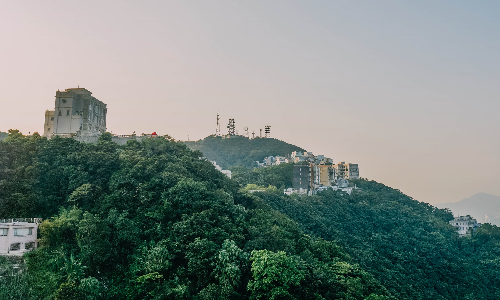
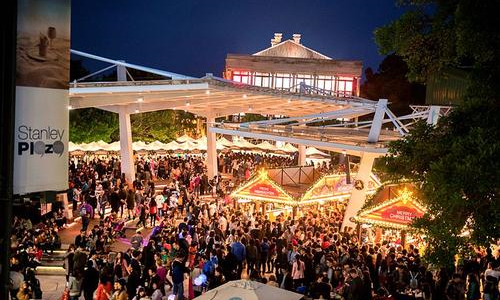
 Guilin
Guilin The short trip to Hong Kong will come to an end, and then we will leave for Guilin by an estimated train of G408 12:05/15:25. So after breakfast, the guide will pick you up at the hotel and transfer you to the railway station, and your lunch will be finished on the train. Fast food, rice, and other snacks are served on the train. After arrival in Guilin, the tour guide will take you to the hotel. You can have a rest after this high-speed train trip.
Guilin is located in the northwest of Hong Kong. An old saying in China is “The landscape of Guilin is the best under the heaven.” The scenery on both sides of Li River is picturesque. When you drifting a bamboo raft on the Li River , you will definitely feel like you are in a Chinese ink painting. Hence the beautiful landscape of Guilin has been printed on the back of the 20-yuan paper currency. The mountain in Guilin ranges rise and fall; the river twists and turns; the mountains are rich in caves and the stalactites in the caves are dazzling in thousands of shapes. In the long history, Guilin’s natural landscape has attracted many literati, poetries, and artists. They had created many famous poems, articles, and paintings and carved more than 2,000 stone carvings.
 Yangshuo
Yangshuo In the morning, you will take a Li River Cruise after breakfast. The Li River originates from the Mao’er Mountain in Xing’an county of Guilin, with a total length of 164 kilometers. The most popular section of the Li River is the route between Guilin and Yangshuo. There are many small villages along the river. You will see buffalo wallowing in the water and many fishermen catching fish. The trip will take about 4 hours. Lunch will be provided on the cruise.
The Li River cruise will dock at Yangshuo. Then you can stroll around the Yangshuo West Street. The Yangshuo West Street, located in the center of the Yangshuo Ancient Town, is about 8 meters wide and 800 meters long. With a history of more than 1,400 years, the street is famous for its cultures and folk-custom, and attracts over ten thousand foreign visitors every year. Many famous people left their footprint in this street, including former US presidents Bill Clinton and Richard Nixon, former US Secretary of State Henry Kissinger, and former UK Prime Minister Margaret Thatcher.
The architecture style of Yangshuo West Street is a combination of Chinese and Western characteristics. Part of the houses on the West Street retains the simplicity and elegance of the buildings in the Ming and Qing Dynasties (1368 - 1912) in northern Guangxi - grey tiles, sloping roofs, whitewashed walls, hanging balconies, and stone streets. While the bars and cafes on both sides of the street are in the European style. Most western restaurants and cafes have their foreign names written on the doorplate. This is because most of the western restaurants and cafes on the street are owned by foreigners who have settled here.
Optional Activity:
In the evening, you can choose to watch a show called “Impression Sanjie Liu”. It is the largest real landscape performance that requires more than 1,000 actors. The background is 12 mountains on the Li River, and the Li River is the stage. It mainly tells the love story of Liu Sanjie. Some actors are the local people. During the day, they may fish, farm or plant. At night, they perform on the stage. They are ordinary people and would like to represent the most beautiful scenery of their hometown to the tourists with their efforts. The first show starts at 8 PM, and the second show starts at 9:35 PM.
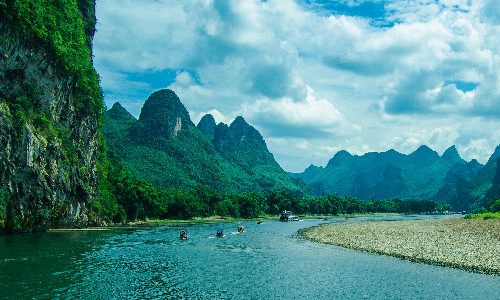
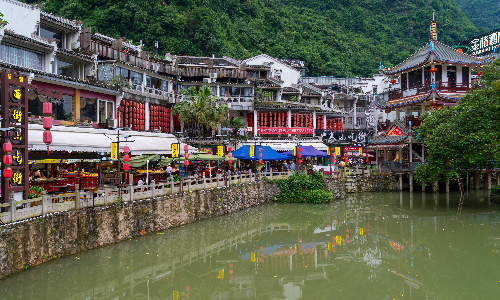
 Guilin
Guilin Xi’an
Xi’an In the morning, after breakfast, you will return Guilin by car. On the way, you can visit an attraction called “Elephant Trunk Hill”. You will have lunch by yourself, but your tour guide will give you some suggestions. After a short rest, you will leave Guilin and head for Xi’an, by an estimated flight JD5144 16:00/17:50.
Xi’an is an ancient city and was the capitals of 13 dynasties. Now it is the provincial capital of Shaanxi Province, located in the northwest of China. The UNESCO (United Nations Educational, Scientific and Cultural Organization) identified the city as the “world-historic and cultural city” in 1981. It is one of the historic and cultural cities following Rome, Athens, and Cairo.
Option: The Big Wild Goose Pagoda Musical Fountain is located in the North Square of the Big Wild Goose Pagoda, which is the largest musical fountain in Asia. The fountain is divided into three areas. Each area could perform independently or three areas could perform together. The musical fountain will perform four times a day at a regular time, each lasting about ten minutes. It is better to watch the fountain show at night, so we recommend you could come to enjoy the show which starts at 7 pm or 9 pm. In addition to the musical fountain, you will also have the opportunity to see the Big Wild Goose Pagoda light show. The Big Wild Goose Pagoda looks more majestic with laser lights and magnificent music.
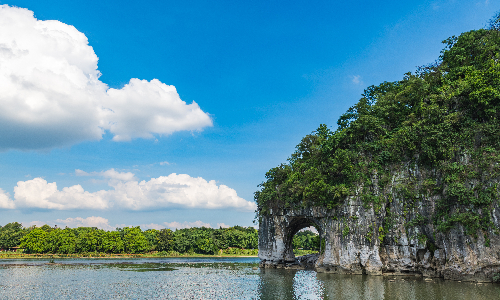
The most famous attraction in Xi’an is undoubtedly the Terracotta Warriors and Horses Museum. It will take about one hour (40 KM) to drive from the city center to the museum in the Lintong District of Xi’an.
Emperor Qinshihuang is the first feudal emperor who built the Qin Dynasty (221 BC - 206 BC), the first feudal dynasty in China. The terra-cotta warriors are the safeguard of his mausoleum. Emperor Qinshihuang believed that he would still be the emperor in the afterworld after his death, so he demanded to put terracotta warriors, chariots and treasures in his mausoleum to preserve his majesty. The discovered warriors are in three pits. The first pit, the largest one, displays over 6,000 warriors. You will see the chariots, cavalrymen, and bowmen in the second pit. In the third pit, the warriors are life-size and classified into three types — general, infantry, and cavalryman. All of the facial expressions of the warriors are different from each other. More than 200 foreign heads of state and government have visited the terra-cotta warriors.
After lunch in a local restaurant, you will have a visit to Xi’an City Wall and Muslim Quarter. The city wall in Xi’an, built in the Ming Dynasty (1368 - 1644), with a history of 600 years, is the oldest and best-preserved ancient city wall in the world. The perimeter of Xi’an City Wall is 13.74 kilometers. The city wall includes a series of military facilities such as the moat, suspension bridges, gate towers, arrow towers, turrets, parapets, and crenels. The city wall is more than ten meters wide. In addition to standing on the city wall and enjoying the beauty of Xi'an, you can also ride bicycles on the city wall.
The last place to be visited is the Muslim Quarter. The Muslim Quarter, featuring its ethnic food and culrure, is about 500 meters long from north to south. You can taste noodles named “biangbiang”, roast meat, beef jerky, haw jelly, and other local dishes. There are 10 mosques of different ages and sizes in this region, the most famous of which is the Great Mosque in Huajue Lane. Many streets in the block have an impressive Islamic style. Walking around the block, you will also find shops selling ethnic clothing, handicrafts and halal snacks.
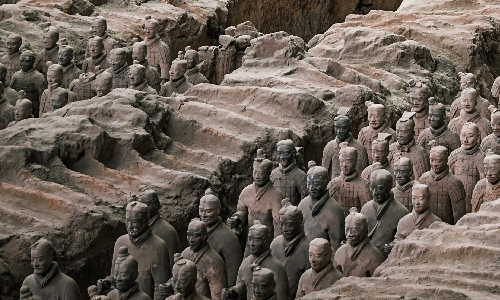
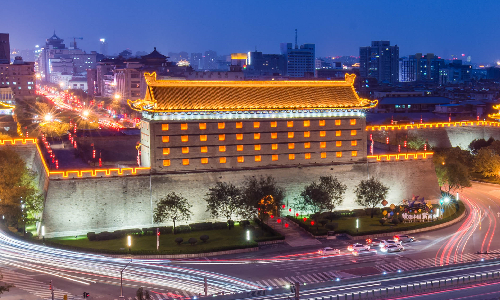
 Shanghai
Shanghai Saying goodbye to Xi’an in the morning, you will take the estimated fight of 9C6402 12:05/14:25 to Shanghai. When you arrive at the airport, the guide in Shanghai will welcome you at the arrival hall. Then you will be transferred to your hotel. For the rest of the day, you can choose to take a rest for the next-day trip or stroll around nearby.
Located in eastern China, Shanghai is a modern metropolis. It is also an economic, financial, and technology innovation center in China. It is the place where the Yangtze River, the longest river in China, empties into the sea. Shanghai is a popular tourist destination with profound modern city culture and numerous historical sites. You'll never feel like there's nothing to do in Shanghai. You can go to the Bund to enjoy the night, go to Hunan Road in Xuhui District to find the most beautiful old houses, go to Nanjing Road for shopping, or go to Hengshan Road for bars and night clubs. Last but not least, don't forget to climb up to the Shanghai Tower and see the charming city.
After breakfast, you will first visit Yu Garden (closed each Monday). Yu Garden is located in Huangpu District in Shanghai, neighboring the City God Temple of Shanghai, and occupies an area of about 20, 000 square meters. It was once a private classical garden built in the Ming Dynasty with a history of more than 450 years. “Yu” means peace and safeness in Chinese. The Yu Garden can be divided into five main parts, the Sansui Hall, the Wanhua Hall, the Huijing Hall, the Yuhua Hall, and the Inner Garden. The famous Sansui Hall was built in 1760 of the Qing Dynasty (1644 - 1912). It is the main body of the Yu Garden. The Sansui Hall was the place to hold official celebrations, and a gathering venue for local scholars, aristocracy, and squires at that time. The Yu Garden is built according to the characters of the south China garden. The layout of private gardens in the south of China is flexible and changeable. Halls, pavilions, and gardens are connected through various paths and corridors.
After about 1 to 2 hours visit to Yu Garden, you will walk into the Old Street. There are more than ten thousand kinds of traditional commodities and dozens of specialty shops in the street. Here you can taste Shanghai's special snacks, such as xiaolongbao. Or you can visit the souvenir stores and choose a small gift with Chinese characteristics for your friends and family.
After lunch, you will visit Shanghai Tower in the Pudong Financial District. Shanghai Tower is adjacent to the Huangpu River and faces the Bund across the river. It is one of the iconic cultural landscapes of Shanghai integrating city sightseeing, catering, shopping and entertainment. Shanghai Tower is 632 meters tall with 119 floors above ground. Its shape resembles a guitar plectrum. It has three high-speed elevators with a speed of up to 18 meters per second. That means in 55 seconds you can reach the Top of Shanghai Observatory located on the 118th floor of Shanghai Tower. There is also a post office on the 118th floor. Each postcard here is a record of the beauty of the Shanghai Tower. You can pick one for yourself or your friends and family and write your own greetings. This is definitely a gift to be treasured.
The next place is the Bund. You may have just seen the Bund from the Shanghai Tower. The Bund is 1.5 kilometers long. 52 classic buildings in different styles stand in the Bund. It is a nice place for taking photo.
Then you will come into a commercial walking street, Nanjing Road. As one of the top ten famous pedestrian streets in China, Nanjing Road is the earliest commercial street. The total length is 1,033 meters and the width is 20-28 meters. Nanjing Road is full of stores and a wide range of goods at good prices. Shanghai locals love to go shopping on Nanjing Road. There are also many famous and century-old stores on Nanjing Road, where you can buy some souvenirs with Chinese features. There are also many large malls and shopping centers where you can find both world famous brands and designer brands. In addition, Nanjing Road is also a great place to try Shanghai snacks, such as fresh meat moon cakes and sweet green rice balls.
At night, you will take the Huangpu River Night Cruise. The Huangpu River cruise tour has always been a must-see in Shanghai. On board, you can enjoy a beautiful view of both sides of the river. You can see the buildings wearing neon lights shining in the night. And if you visit on vacations, you may watch the fantastic light shows.
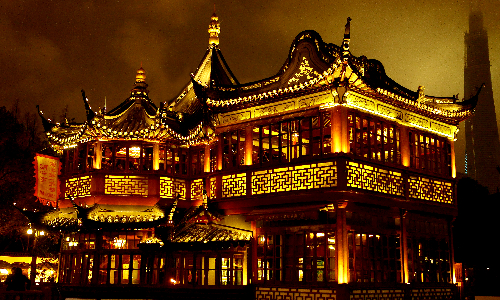
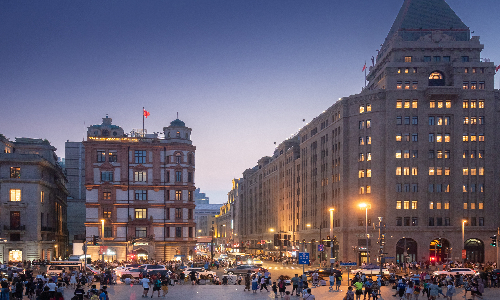
 Beijing
Beijing Shanghai trip is ending and you will go to Beijing, the capital of China by an estimated train G124 10:58/16:17. You will have your lunch on the train. After arrival, the guide in Beijing will meet you at the railway station and drive you to the hotel.
Beijing is the heart of China’s politics, culture, international exchanges, science, and technological innovation. It is an ancient capital with a history of more than three thousand years, so Beijing had different names in different dynasties, roughly more than twenty names. Many palace buildings were built, making Beijing the city with the largest number of imperial palaces, gardens, temples, and tombs in China.
Optional activity:
In the evening, you can visit Wangfujing Street. Wangfujing Street, located southeast of the Forbidden City and close to Tian’anmen Square, is one of the most popular streets in Beijing. Wangfujing Street is a collection of famous snacks from Beijing and other cities, where you can taste not only Beijing traditional snacks, such as meat sauce noodles and sugar-coated haws, but also special snacks from all over the country, such as Shanghai xiaolongbao and Xi'an Rougamo. In addition to snacks, there are also stalls specializing in selling and making folk crafts. Many handicrafts handed down in folklore are shown here.
After breakfast, we will visit Tian’anmen Square. Located in the heart of Beijing, Tian’anmen Square is 880 meters long from north to south and 500 meters wide from east to west with an area of 440,000 square meters. Along the central axis of Beijing from north to south, there are the National Flag Pole, the Monument to the People’s Heroes, the Chairman Mao Memorial Hall, and the Zhengyangmen Gate Tower on the square.
On October 1st, China’s National Day, thousands of people will gather in Tian’anmen Square at wee hours, and some people even come here at midnight to occupy a position to watch the flag-raising ceremony. On October 1st, 1949, Tian’anmen Square witnessed the founding ceremony of the People’s Republic of China.
The Monument to the People’s Heroes, built in 1952 and finished in 1958, is to commemorate the revolutionary martyrs in modern and contemporary Chinese history. It has a total height of 37.94 meters. On the front side, there are eight Chinese characters inscribed by Chairman Mao Zedong (the founder of the People’s Republic of China) on June 9th, 1955. The eight Chinese characters mean “the heroes of the people are immortal.”
After that, we will enter the Forbidden City (closed each Monday). It is the imperial palace of the Ming and Qing Dynasties (1368 - 1912) in China, located at the center of the central axis of Beijing. It is world famous as one of the top five palaces in the world (the other four are Versailles in France, Buckingham Palace in the UK, Kremlin in Russia, and the White House in the USA). The Forbidden City covers an area of 720,000 square meters, with more than 70 palaces, and more than 9,000 houses.
The Forbidden City was where the emperors lived and conducted state affairs with the official in feudal times. There are three main halls in the inner court. They are Hall of Supreme Harmony (Taihe dian), Hall of Central Harmony (Zhonghe dian) and Hall of Preserving Harmony (Baohe dian). The Hall of Supreme Harmony was used to hold various ceremonies. It was used very few times. For the Hall of Central Harmony, the emperors usually take rest and prepared here before attending large celebrations at the Hall of Supreme Harmony. The Hall of Preserving Harmony in the Ming and Qing dynasties for different purposes. In the Ming dynasty, the emperors often changed clothes here before attending the ceremonies. When the empress or the crown prince was crowned, the emperor received congratulations at this hall. In the Qing Dynasty, every year on Lunar New Year's Eve and the 15th day of the first lunar month, the emperors would invite all officials here for a banquet, which was a spectacular scene. The wedding of Emperor Shunzhi was also held here.
The center of the inner court was the Palace of Heavenly Purity, the Hall of Union, and the Palace of Earthly Tranquility, collectively known as the Three Palaces in Inner Court. The three main palaces are the places the emperor and the empress lived. There are six palaces on each side of the three main palaces, where the concubines lived.
In addition to its unique architectural style, the Forbidden City is also a treasure trove of ancient Chinese cultural and artistic works. Over one million precious cultural relics are collected in the Forbidden City, accounting for one-sixth of the total cultural relics in China. At the Hall of Clocks every day at 11 AM and 2 PM, a clock show will begin. A total of 123 clocks and watches made in China and abroad in the 18th century will be on display. The museum staff will wind the clocks in advance. Each clock display is for three minutes.
After lunch, you will visit an imperial garden, the Summer Palace. It is the best-preserved imperial garden in China, known as the “Museum of Royal Gardens”. Summer Palace occupies an area of 2.97 square kilometers mainly composed of Longevity Hill and Kunming Lake. There are more than 3,000 palaces and buildings in the garden. It is worth mentioning a long corridor located at the southern foot of Longevity Hill. It is the longest corridor in Chinese gardens with a total length of 728 meters. In 1992, it was identified as the longest corridor in the world and listed in the “Guinness World Records”. More than 14,000 paintings are painted on each beam of the corridor, with the content of landscape, flowers, birds, fish, insects, and literary figures. The figures in the paintings are all for Chinese classics.
For dinner, you can try the most special food in Beijing - Peking Roast Duck. Whether you want to dine at a fancy restaurant or a local one, your guide will help you with the best suggestions.
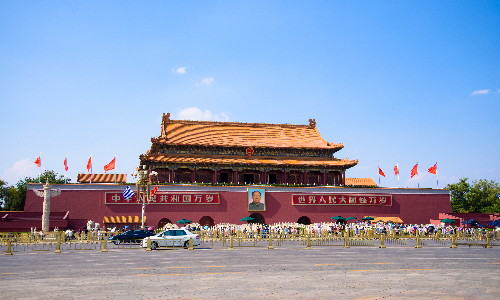
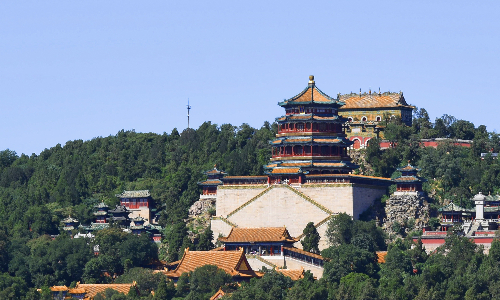
Today we will first visit the Sacred Way. It is located in the northwest of Tian’anmen Square. It takes about 1.5 hours (50 KM) by car. It is the leading part of the Chang Tomb, with a total length of about 7.3 kilometers. From south to north, Stone Memorial Archway, Grand Red Gate, Stone Statue, Dragon and Phoenix Gate, and a series of tomb decorations and constructions are displayed. Stone Memorial Archway was built in the 19th year (1540) of the reign of Emperor Jiajing.
The Chang Tomb is the best of the Ming Tombs. The Ming Tombs located in Changping District in Beijing have buried 13 emperors, 23 empresses, and two princes of the Ming Dynasty (1368 - 1644). It covers an area of over 120 square kilometers. The Chang Tomb was the tomb for Emperor Zhu Di (the third emperor of the Ming Dynasty and his reign is praised as “Yongle Flourishing Age”) and his empress. It was built in 1409 and covers an area of 120,000 square meters.
After lunch, you will visit Juyongguan Great Wall. We will drive southwest about 30 minutes (17 KM) from the Chang Tomb to the Juyongguan. The Great Wall is the longest and largest ancient defense project in China and the world. It has been continuously built for more than 2,000 years, covering a vast area of northern and central China, with a total length of more than 20,000 kilometers. The Great Wall is not a single isolated wall, but a defensive system with the wall as the main body as well as watchtowers, fortresses, passes, and beacon towers.
Juyongguan is one of the major passes. A tablet hanging on the gate wall is written “the greatest pass under Heaven.” It is said that “One who fails to reach the Great Wall is not a hero”. This is one of the reasons why many people who come to Beijing must visit the Great Wall. It takes about 2 to 3 hours to climb to the highest beacon tower. Here you could see a beautiful sight of the mountains.
On the way back to your hotel, we will stop at the Olympic Village for you to take some photos. The Bird's Nest and the Water Cube are a perfect background of your photos.
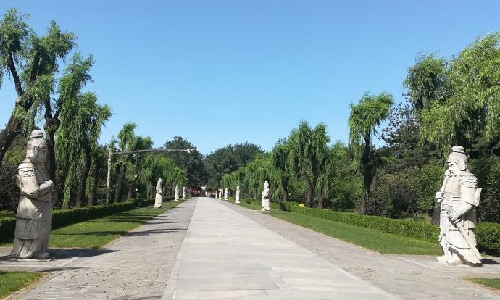
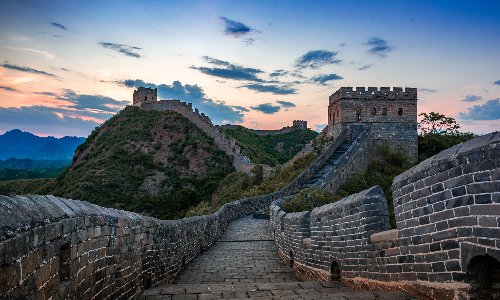
Your 12-day trip to China is coming to an end. The tour guide will meet you at the hotel lobby and take you to the airport according to the time of your flight. We hope you have a pleasant journey and hope to see you in the future.
Author: Beibei Yang
Proofreader: Carrie Zhang
| City | Five Star hotel list | Four Star hotel list |
|---|---|---|
| Hong Kong | Harbour Grand Kowloon | Harbour Plaza North Point Hotel |
| Guilin | Lijiang Waterfall Hotel | Guilin Bravo Hotel |
| Yangshuo | Yangshuo Greenlotus Hotel | New Century Hotel |
| Xi'an | Tianyu Gloria Grand Hotel Xi'an | Sunworld Dynasty Hotel |
| Shanghai | Ocean Hotel Shanghai | Courtyard by Marriott Shanghai Central |
| Beijing | Sunworld Dynasty Hotel Beijing Wangfujing | Sunworld Hotel Wangfujing |
 |
![]() About your child or infant, please contact us for a discounted price.
About your child or infant, please contact us for a discounted price.



We started with a few days in Beijing & ended in Shanghai, from where we visited the Forbidden City and Great Wall. In between we visited Terra Cotta Warriors Museum, Panda Base, Shanghai Disneyland.

We had a wonderful holiday in China which will remain long in the memory. China is a breathtakingly beautiful country full of splendid temples and palaces, mountains and rivers, peaceful rural scenes and bustling shopping streets.
 QUICK ENQUIRY
QUICK ENQUIRY